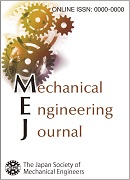Volume 7, Issue 2
Displaying 1-10 of 10 articles from this issue
- |<
- <
- 1
- >
- >|
Solid Mechanics and Materials Engineering
-
2020 Volume 7 Issue 2 Pages 19-00477
Published: 2020
Released on J-STAGE: April 15, 2020
Advance online publication: February 12, 2020Download PDF (2033K) -
2020 Volume 7 Issue 2 Pages 19-00272
Published: 2020
Released on J-STAGE: April 15, 2020
Advance online publication: March 16, 2020Download PDF (1544K) -
2020 Volume 7 Issue 2 Pages 19-00634
Published: 2020
Released on J-STAGE: April 15, 2020
Advance online publication: March 19, 2020Download PDF (1132K) -
2020 Volume 7 Issue 2 Pages 20-00010
Published: 2020
Released on J-STAGE: April 15, 2020
Advance online publication: March 19, 2020Download PDF (1819K)
Thermal, Engine and Power Engineering
-
2020 Volume 7 Issue 2 Pages 19-00193
Published: 2020
Released on J-STAGE: April 15, 2020
Advance online publication: March 09, 2020Download PDF (1169K) -
2020 Volume 7 Issue 2 Pages 19-00457
Published: 2020
Released on J-STAGE: April 15, 2020
Advance online publication: March 11, 2020Download PDF (2549K)
Dynamics & Control, Robotics & Mechatronics
-
2020 Volume 7 Issue 2 Pages 19-00443
Published: 2020
Released on J-STAGE: April 15, 2020
Advance online publication: February 12, 2020Download PDF (1688K) -
2020 Volume 7 Issue 2 Pages 19-00051
Published: 2020
Released on J-STAGE: April 15, 2020
Advance online publication: February 13, 2020Download PDF (2719K) -
2020 Volume 7 Issue 2 Pages 19-00482
Published: 2020
Released on J-STAGE: April 15, 2020
Advance online publication: March 10, 2020Download PDF (4304K)
Transportation and Logistics
-
2020 Volume 7 Issue 2 Pages 19-00572
Published: 2020
Released on J-STAGE: April 15, 2020
Advance online publication: February 28, 2020Download PDF (1792K)
- |<
- <
- 1
- >
- >|
